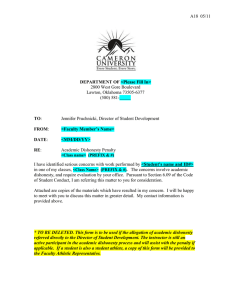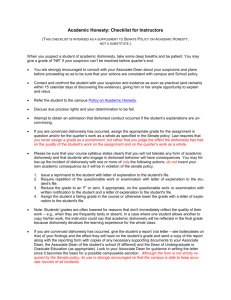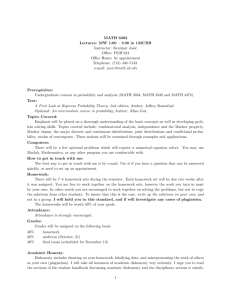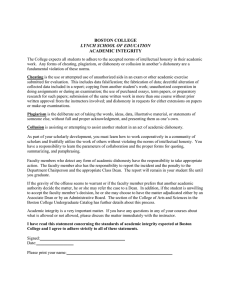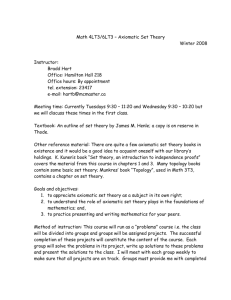29 April 1999 TO: Faculty Senate FR: John T. English
advertisement
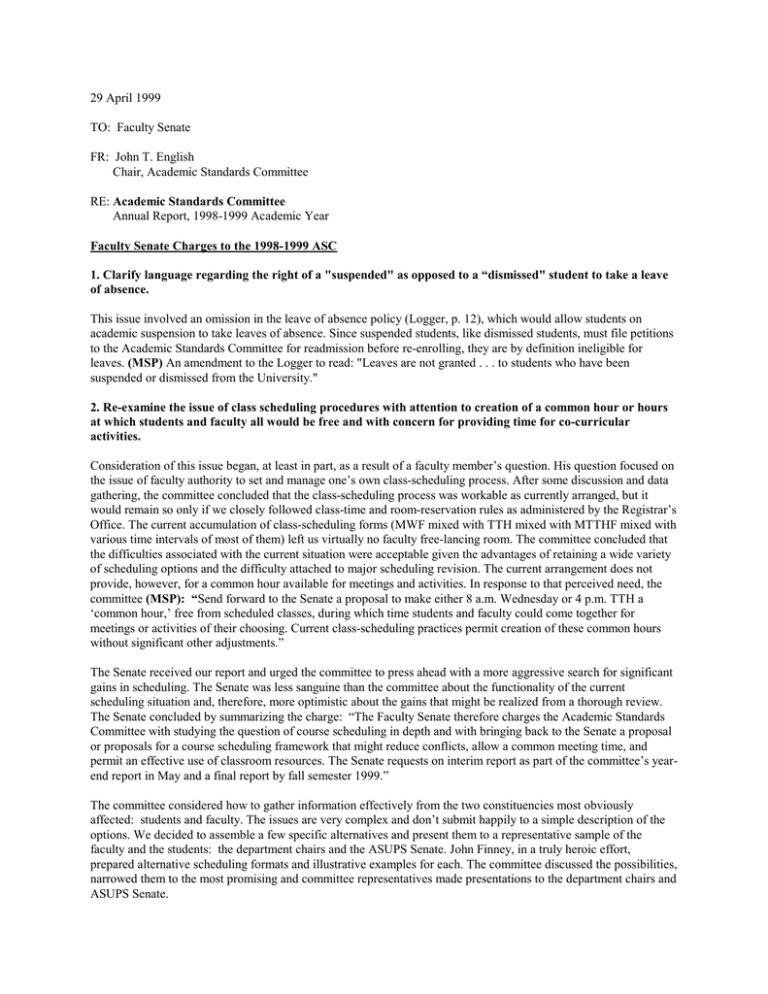
29 April 1999 TO: Faculty Senate FR: John T. English Chair, Academic Standards Committee RE: Academic Standards Committee Annual Report, 1998-1999 Academic Year Faculty Senate Charges to the 1998-1999 ASC 1. Clarify language regarding the right of a "suspended" as opposed to a “dismissed" student to take a leave of absence. This issue involved an omission in the leave of absence policy (Logger, p. 12), which would allow students on academic suspension to take leaves of absence. Since suspended students, like dismissed students, must file petitions to the Academic Standards Committee for readmission before re-enrolling, they are by definition ineligible for leaves. (MSP) An amendment to the Logger to read: "Leaves are not granted . . . to students who have been suspended or dismissed from the University." 2. Re-examine the issue of class scheduling procedures with attention to creation of a common hour or hours at which students and faculty all would be free and with concern for providing time for co-curricular activities. Consideration of this issue began, at least in part, as a result of a faculty member’s question. His question focused on the issue of faculty authority to set and manage one’s own class-scheduling process. After some discussion and data gathering, the committee concluded that the class-scheduling process was workable as currently arranged, but it would remain so only if we closely followed class-time and room-reservation rules as administered by the Registrar’s Office. The current accumulation of class-scheduling forms (MWF mixed with TTH mixed with MTTHF mixed with various time intervals of most of them) left us virtually no faculty free-lancing room. The committee concluded that the difficulties associated with the current situation were acceptable given the advantages of retaining a wide variety of scheduling options and the difficulty attached to major scheduling revision. The current arrangement does not provide, however, for a common hour available for meetings and activities. In response to that perceived need, the committee (MSP): “Send forward to the Senate a proposal to make either 8 a.m. Wednesday or 4 p.m. TTH a ‘common hour,’ free from scheduled classes, during which time students and faculty could come together for meetings or activities of their choosing. Current class-scheduling practices permit creation of these common hours without significant other adjustments.” The Senate received our report and urged the committee to press ahead with a more aggressive search for significant gains in scheduling. The Senate was less sanguine than the committee about the functionality of the current scheduling situation and, therefore, more optimistic about the gains that might be realized from a thorough review. The Senate concluded by summarizing the charge: “The Faculty Senate therefore charges the Academic Standards Committee with studying the question of course scheduling in depth and with bringing back to the Senate a proposal or proposals for a course scheduling framework that might reduce conflicts, allow a common meeting time, and permit an effective use of classroom resources. The Senate requests on interim report as part of the committee’s yearend report in May and a final report by fall semester 1999.” The committee considered how to gather information effectively from the two constituencies most obviously affected: students and faculty. The issues are very complex and don’t submit happily to a simple description of the options. We decided to assemble a few specific alternatives and present them to a representative sample of the faculty and the students: the department chairs and the ASUPS Senate. John Finney, in a truly heroic effort, prepared alternative scheduling formats and illustrative examples for each. The committee discussed the possibilities, narrowed them to the most promising and committee representatives made presentations to the department chairs and ASUPS Senate. 2 The chairs paid particular attention to the models in which 4-day courses become MWF courses with a 4th session scheduled for either Tu or Th. The departments in which the faculty currently teach 4-day courses commented that they would prefer not to have to shift their schedules. Overall, however, the chairs expressed a willingness to consider the problem and to pursue solutions. Feedback from the ASUPS Senate meeting revealed some skepticism about the need for a common hour. Students tend to be involved in several clubs so, they felt, clearing up a designated time slot might lead to the scheduling of dueling meetings in this slot. Some students were concerned that restricting seminars to after 6 PM might be problematic, as almost all student meetings occur in the evening, and some expressed concern about the dissociated hour in 4-day classes. These are legitimate concerns and must be considered as the discussion continues. However, Finney’s analyses suggest that the effects of the dissociated hour, though difficult to accept on an intuitive level, are minimal. The stage is set for the committee to continue discussion in Fall 1999. More clearly developed scheduling alternatives and significantly more useful analyses of the alternatives are now available. Finney’s efforts in this regard have been tremendously helpful. This should be a continuing charge. 3. Examine the Pass/Fail system, its uses and implications. The committee considered the present “condition” of the P/F option. According to MIRS 206, 1546 (13%) of 11863 grades awarded in Spring 1998 were "P," and of those 1003 came from the departments of Physical Education and Music, where most P/F grades are awarded in P/F-only courses. Taking the difference, 543 "P" grades represent 4.5% of grades awarded last spring, most of these in courses in which P/F was elected. This modest number of enrollments reflects both University constraints and a decline in student interest in the P/F. The details of these enrollments offer evidence that many students did appear to use the option to explore outside their majors, one of the desired effects. Evidence of apparent abuse was there, as well, but on balance the committee did not find enough evidence of abuse to justify proposing a P/F curtailment or elimination. Committee members noted several means available for preventing P/F enrollments from squeezing out majors: set asides, permission signature requirements, or a permit system can all ameliorate a problem should it occur. The committee concluded that the evidence did not warrant acting to change P/F policy at this time. 4. Re-examine the idea of an Ethics or Honor Code for the University. Early discussion focused on the value of an integrated code process, in contrast to our current separate academic honesty and integrity code arrangement. Committee members did not see an advantage to the change, particularly given the apparent effectiveness of our current practices. The committee was attracted, however, to the set of academic honesty exercises developed by Inger Brodey, Ann Ekes Wilson, and Jeanette Di Scala (1996-1997). Further discussion within the committee and with colleagues in departments around the campus did not support any sense that our policies were broken. The committee did concur with Tom Gething’s characterization of a healthy academic honesty climate as one where faculty send a message about its importance to students in the classroom every term. In his experience and in the research on the topic, this factor clearly emerges as the key. As a result of these discussions, the committee took the following actions: MSP to recommend that an annual letter be sent to faculty reminding them of our academic honesty policy and process, and encouraging them to report instances of academic dishonesty. (The letter might be sent most productively just before each Fall midterm, after the blizzard of early-semester emails has relented a bit.) The committee prepared a draft letter (appended) for committee consideration next year. MSP to commend the Academic Honesty and Intellectual Ownership teaching guide on plagiarism developed by Wilson, Di Scala and Brodey to the Faculty Senate and recommend that the teaching guide be forwarded to the Curriculum Committee with a request to consider its incorporation in first-year writing seminars. 5. Review the new Medical Withdrawal and Re-entry policies near the end of Spring Semester 1999. 3 The committee did not get to this item. It could be moved to the list of charges for next year’s committee. Other Topics Considered Class Disruption Policy: The committee members considered whether they had seen an increase in disruptive behaviors of all kinds (students chattering, arriving late, sleeping in class, speaking out inappropriately or aggressively, etc.). Consensus was that such disruptions, while they did occur, were infrequent and insignificant enough that they did not pose a serious problem on our campus The committee considered Roundy’s concern that the "Disruptive Class Behavior" policy (Logger, p. 45) lacks a clearly stated "due process" step, whereby students could appeal faculty action against them. Committee discussion concluded that this was an appropriate concern and that a clarifying sentence should be added to the Disruption statement insuring "fundamental fairness" to the process. MSP: The following statement should be inserted at the end of the paragraph on class disruption, following the sentence which ends, "... drop the student from the course": "Students wishing to appeal an administrative drop for class disruption may do so by petition to the Academic Standards Committee. In such cases, students will continue to be barred from class until the committee renders its decision." Suggestions For Charges For Academic Year 1999-2000: 1. Science in Context: Request the Curriculum Committee reconsider the two Natural World prerequisites for Science in Context courses. The ASC receives a significant number of petitions every year from students wishing to either waive a Natural World prerequisite or to take it concurrently with their Science in Context course. The ASC finds itself making decisions that often feel arbitrary, often based on scheduling constraints, rewarding delinquent students, and causing disarray in the senior years of others. Those of us on the ASC who teach Science in Context courses find that the prerequisites are not necessary. For most students, the Natural World courses do not directly prepare them for their Science in Context course, and instructors must develop the necessary background material within the courses. We find, as well, that our junior and senior students have developed adequate analytical skills and are sufficiently versed in the scientific method to take Science in Context without the Natural World prerequisites. 2. Course Scheduling: Renew the Senate’s charge to the ASC: “The Faculty Senate therefore charges the Academic Standards Committee with studying the question of course scheduling in depth and with bringing back to the Senate a proposal or proposals for a course scheduling framework that might reduce conflicts, allow a common meeting time, and permit an effective use of classroom resources. The Senate requests on interim report as part of the committee’s year-end report in May and a final report by fall semester 1999.” 3. Academic Honesty: Forward the Academic Honesty and Intellectual Ownership teaching guide referred to above (item 4) to the Curriculum Committee with a request to consider its incorporation in first-year writing seminars. 4. Medical Withdrawal and Re-entry: Review the new Medical Withdrawal and Re-entry policies near the end of Spring Semester 2000. 5. Academic Honesty: Review draft Academic Honesty letter and send to faculty before midterm, Fall 1999. Academic Honesty Letter Dear Colleagues, 4 The Academic Standards Committee revisited the issue of academic honesty this past year. Although most faculty agree that academic dishonesty is not a major problem at UPS, violations of academic honesty do occur regularly. Virtually every faculty member with whom the issue was discussed during an informal survey has had some experience dealing with violations of Academic Honesty. Most faculty said that they deal with most violations informally, rather than by filing an official report. Various reasons for non-reporting were given: 1) they were unclear about the policies and procedures for reporting cases; 2) they didn’t want the case to get out of their hands; 3) they didn’t want to spend the time filling out an official report or 4) they were worried about tarnishing an otherwise good student’s record. The lack of reporting leads to at least two problems: 1) Non-reporting makes it easier for habitual offenders to repeat, and 2) non-reporting makes it impossible to have any way of actually assessing the extent of the problem. We hope that by clarifying the procedures and emphasizing that one time offenders have no permanent record that we encourage more faculty to take the little bit of extra time to fill out incident reports. A recent article in the Chronicle of Higher Education (January 22, 1999, vol. XLV, no. 20) discusses research that shows that vigilance is the most effective preventive measure, but reported a number of academic dishonesty cases across the country in which faculty expressed concerns that they did not have the full support of their administrations. In our discussions of this issue we have been assured that lack of administrative support will not be a problem here. To encourage reporting and clarify the procedures we thought it best to excerpt the relevant sections of the academic honesty policy from The Logger 1998-1999: “The suspicion of dishonesty in the academic community is a serious matter because it threatens the atmosphere of respect essential to learning. Academic dishonesty can take many forms, including but not limited to the following: plagiarism, which is the misrepresentation of someone else's words, ideas, research, or computer program (including stacks, spreadsheet macros, command files, etc.) as one's own; submitting the same paper or computer program for credit in more than one course without prior permission; collaborating with other students on papers or computer programming assignments and submitting them without instructor permission; cheating on examinations; mistreatment of library materials; violation of copyright laws (see the Copy Center's handbook for a summary of copyright guidelines); forgery and misuse of academic computing facilities.” (4-5) The Logger also specifies procedures for reporting cases of academic dishonesty: 1. If a faculty member has reason to suspect academic dishonesty, the following actions are taken: a. The faculty member notifies the student that she or he suspects an instance of academic dishonesty and that an appropriate response will be made. b. The faculty member meets with the student as a part of the process of determining if an instance of academic dishonesty has occurred. This meeting can happen by phone or mail if the semester has ended or for other reasons the student is not available on campus. If the student is unreachable, then the faculty member determines responsibility based on the available evidence. c. If the faculty member determines that an instance of academic dishonesty has occurred, he or she submits to the Registrar an Academic Dishonesty Incident Report (available from the Office of the Registrar), including reasonable documentation and the recommended penalties to be imposed. The faculty member must provide a copy of the form to the student. The Registrar informs the faculty member if this is the student's first offense or not. d. If there has been no prior reported instance of academic dishonesty, the penalties imposed by the faculty member conclude the case unless either the student or the faculty member asks for a Hearing Board (see below). 2. When step 1c is reached and if a previous act of academic dishonesty has been reported to the Office of the Registrar, the following actions are taken: 5 a. The Registrar notifies the faculty member that at least one previous case has been reported. b. The Registrar asks that a Hearing Board be convened to consider the case and to apply appropriate sanctions (see Step 3 of the Hearing Board Procedures listed in the next section). The faculty member's proposed sanctions are forwarded to the board; however, depending on the gravity of the offense, the board may impose any of the sanctions described in Step 6 of the Hearing Board procedures listed below. 3. The Academic Dishonesty Incident Report forms are retained in a confidential file maintained by the Registrar only during the time of the student's enrollment at the University. Their purpose is to provide a record of instances of academic dishonesty in the event that any subsequent such reports are submitted. Contents of the Academic Dishonesty Report Forms and subsequent Hearing Board actions are revealed only with the written consent of the student, unless otherwise permitted or required by the Family Educational Rights and Privacy Act. No entry is made on the student's permanent academic record of an instance of academic dishonesty, unless so directed by a Hearing Board. (8-9) Research on this topic clearly indicates that universities with low instances of academic dishonesty cases tend to be those that regularly discuss the issue, the specific policies, and the consequences concerning dishonesty. The Academic Standards Committee has also made a recommendation that the English Department include not only a discussion of the policy but also an overview of what constitutes academic dishonesty in all English 101 classes. We strongly encourage all faculty to routinely revisit the policy in their classes, at all levels and in all disciplines. Thank you, Academic Standards Committee
